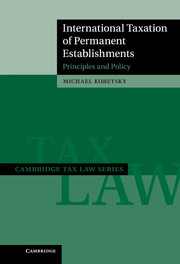Book contents
- Frontmatter
- Contents
- Abbreviations
- 1 Introduction
- 2 International taxation: policy and law
- 3 Some shortcomings of the tax treaty system
- 4 History of tax treaties and the permanent establishment concept
- 5 The role of the OECD Model Tax Treaty and Commentary
- 6 Defining the personality of permanent establishments under former Article 7 and the pre-2008 Commentary and the 2008 Commentary
- 7 Intra-bank loans under the pre-2008 Commentary and 1984 Report
- 8 Intra-bank interest under the 2008 Report
- 9 Business restructuring involving permanent establishments and the OECD transfer pricing methods
- 10 New Article 7 of the OECD Model and Commentary
- 11 Unitary taxation
- 12 Conclusion
- Bibliography
- Index
8 - Intra-bank interest under the 2008 Report
Published online by Cambridge University Press: 07 September 2011
- Frontmatter
- Contents
- Abbreviations
- 1 Introduction
- 2 International taxation: policy and law
- 3 Some shortcomings of the tax treaty system
- 4 History of tax treaties and the permanent establishment concept
- 5 The role of the OECD Model Tax Treaty and Commentary
- 6 Defining the personality of permanent establishments under former Article 7 and the pre-2008 Commentary and the 2008 Commentary
- 7 Intra-bank loans under the pre-2008 Commentary and 1984 Report
- 8 Intra-bank interest under the 2008 Report
- 9 Business restructuring involving permanent establishments and the OECD transfer pricing methods
- 10 New Article 7 of the OECD Model and Commentary
- 11 Unitary taxation
- 12 Conclusion
- Bibliography
- Index
Summary
Introduction
This chapter critically considers measures in the 2008 Report on the application of former Article 7. This chapter shows the OECD's approach to be theoretically flawed, complex and costly to apply to branches of international banks and other international enterprises because they are not separate entities engaging in arm's length transactions with associated enterprises. The interpretation of the arm's length principle advocated in the 2008 Report – called the ‘authorized OECD approach’ – is based on legal fictions and does not reflect business practice. In addition, the OECD's approach may not result in a consensus interpretation of former Article 7 by the OECD countries. Although the OECD has established the authorized OECD approach, it may not be consistently implemented by OECD countries because each country will be acting in its own self-interest. A lack of consensus will inevitably result in double taxation or under-taxation, and disputes with taxpayers. One major issue on which the OECD was unable to establish a single authorized OECD approach was on the method for allocating equity capital to branches of international banks. As a compromise measure, several authorized approaches may be used, but this will lead to double taxation or under-taxation if an international bank's residence country and the host country, in which it has a permanent establishment, use different methods for allocating equity capital to bank branches; resolving the double taxation disputes will be costly and time consuming.
The chapter begins with the allocation of business profits to permanent establishments under former Article 7 of the OECD Model and the adjustment of profits for transactions between associated enterprises under Article 9 as set out in the Transfer Pricing Guidelines. Next the chapter examines the authorized OECD approach for the allocation of business profits to permanent establishments. It then illustrates that the authorized OECD approach is based on the arm's length principle under Article 9 for associated enterprises and that these rules are different to the rules developed under former Article 7 for permanent establishments. The chapter traces the origins of the OECD's transfer pricing rules to the domestic US transfer pricing rules for associated enterprises. The chapter then considers the treatment of a permanent establishment as a functionally separate enterprise under the authorized OECD approach. The chapter examines the measures under the first step of the authorized OECD approach for the allocation of equity capital to bank branches, and the chapter then critically reviews the difficulty of allocating equity capital to bank branches. Finally, the chapter focuses on some of the flaws of the first step of the authorized OECD approach.
- Type
- Chapter
- Information
- International Taxation of Permanent EstablishmentsPrinciples and Policy, pp. 276 - 315Publisher: Cambridge University PressPrint publication year: 2011



